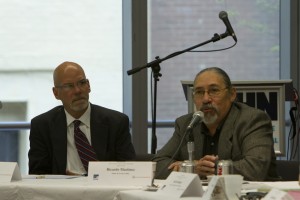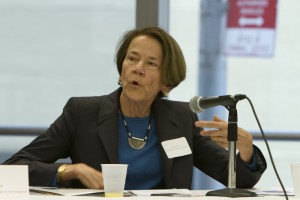
NEW YORK – The John Jay College of Criminal Justice’s Center on Media, Crime and Justice is holding a two-day conference for journalists on its campus in New York Monday and Tuesday.
JJIE/Youth Today’s John Fleming and Clay Duda are attending the conference and will be reporting some highlights throughout.
While the conference, Kids Behind Bars, Where’s the Justice in America’s Juvenile Justice System?, is primarily meant for journalists, many of the topics will be of interest not only to those in the field, but the general public as well.
 Speakers on Monday include: Mark Soler, executive director of the Center for Children’s Law & Policy; Vincent Schiraldi, commissioner of New York City’s Department of Probation; Ricardo Martinez, co-director, Padres & Jovenes Unidos and David Utter, director of policy, the Florida office of the Southern Poverty Law Center.
Speakers on Monday include: Mark Soler, executive director of the Center for Children’s Law & Policy; Vincent Schiraldi, commissioner of New York City’s Department of Probation; Ricardo Martinez, co-director, Padres & Jovenes Unidos and David Utter, director of policy, the Florida office of the Southern Poverty Law Center.
Gail Garinger, a former juvenile court judge, who is now the Child Advocate of Massachusetts’ Office of the Child Advocate, will deliver the keynote address.
The Tow Foundation is sponsoring the conference.
For coverage of Day Two head to our post here.
DAY ONE:
Panel One:

Mark Soler
In her keynote address Gail Garinger spoke about the now discounted superpredator theory from the 1990s and role of the press in giving life to the myth through screaming headlines and sensational stories. The theory was posited by John DiIulio of Princeton, James Fox of Northeastern and others in the early 1990s.
It was, Garinger said, an unfortunate time that led to changes in laws in most states that resulted in many more juveniles being tried as adults.
The wolf pack of the superpredatory youth, however, never materialized she said, causing the very social scientists who brought up this theory to discount it.
But the highly punitive laws are still on the books in most states. Though change is coming, it is slow.
One big problem, Garinger told the more than 100 journalists and policy-makers assembled, is a disconnect that exists between lawmakers and good law. Garinger mentioned instances when she would urge lawmakers in Massachusetts to consider existing laws before implementing often-counterproductive laws because of press and public pressure.
Garinger spoke a bit from her own experience, telling the audience that she had three kids come into their teenage years within 17 months.
“I can’t believe the stupid things kids do”, she said. Sometimes, she added, they even film themselves on videotape, smoking pot in the basement and so on.
That towering stupidity, she stressed, is just another reason why we need to pay attention to the importance of brain science.
In recent years scientists have determined the human brain does not reach full maturity until well past the teen years.
She added this is one of the key issues of juvenile justice today. Other include coordination of the players involved in kids lives; risk assessment tools including evidence-based practices; diversion; what programs work for special populations; sex offenders; mental health needs; racial disparities; confidentiality of court records and the availability of data.
In response to a question about mentoring, Garinger said if a kid has a meaningful involvement with a caring adult, it could make a world of difference, that one significant person can make a difference, she said.
She also stood up for those seeking more aggregate data on juvenile offenders from state agencies.
Journalists have often battled state departments of juvenile justice for such data. State DJJs often site privacy as a reason for withholding data even when only aggregate data is asked for.
Mark Solar chaired a panel following Garinger’s talk that focused on lessons learned from the superpredator years and the falling crime rates the nation has witnessed in recent years.

David Utter, left, and Ricardo Martinez, right, speaking at the John Jay conference
Ricardo Martinez, the co-director of Padres & Jovenes, spoke about teen stupidity as well.
Authorities, he said, take simple stupid behavior and find a law to fit it. Martinez, who is based in Denver, said the current policies used by many schools, including some in Denver, are part of a factory to create a nation with the highest incarceration of youth on the planet.
All of this starts with discipline in the schools, he said. Existing policies, he said, push the students out of the schools onto the streets and into trouble.
The thought by many school administrators, he said, is to throw out the bad kids so the good kids can learn. But, he said, his organization has yet to find a school that is throwing kids out and doing well academically.
Martinez also spent some time on what he sees as a concerted effort by the system to disenfranchise entire segments of society.
It is no accident, he explained, that zero tolerance has coincided with a change in demographics in the United States. “It is not an accident, it is a question of changing demographics,” he said.
David Utter, of the Southern Poverty Law Center (SPLC), spoke of the important role the media can play in exposing problems in the system. He referred to reports that have been done by Human Rights Watch and the SPLC in past years documenting abuses in youth detention centers that eventually got the notice of public and the Justice Department, in part, because of the work of the media.
Utter also spoke about racial disparity in the juvenile and adult correctional systems. It is across the board, Utter said, in every facility minority kids are overrepresented and the deeper you get into the system the more disparity you see.

Conference attendees, including JJIE editor John Fleming, center
Mark Soler closed by asking all the attendees to go visit the youth detention center in their area and meet the kids and “you will see that most of them have dark skin.
Vincent Schiraldi, commissioner of New York City’s Department of Probation, talked about the history of juvenile incarceration, saying that it has from the beginning been a disaster.
We should ask what’s wrong with the model we are using, he said.
He talked about New York City’s effort to take its incarcerated youth out of the state’s mechanism. This is a big deal, Schiraldi said, when the biggest city in the nation chooses to do this. And he added, New York is not alone, referring to realignment in California and experiments in Texas, Detroit and Chicago.
He closed by pointing out that there is a lot of evidence to show that kids sent into big facilities are more prone to reoffend, to have poor education and employment outcomes and for their mental health condition to worsen and in some instances be the reason for an onset of mental illness.
Panel Two:

Elizabeth Scott
Elizabeth Scott, a professor of law at Columbia University Law School, moderated a panel on juvenile justice reforms and politics. The main question she and other panelists asked was: Will deinstitutionalization and other reforms last?
The other panelists included: Gladys Carrion, the Commissioner of New York State’s Office of Children and Family Services; Marc Levin, director of Center for Effective Justice, Texas Policy Foundation and Daniel Chaney, director of the Juvenile Services Division of the Department of Children and Family Services in Wayne County, Mich.
Scott said knowledge of adolescent behavior tends to make for better policy, adding that there is little question that detention is a potentially toxic environment for juveniles. Alternatives to detention, she said, have been shown to be more effective in many instances.
Progress is being made, changes are being implemented, but the next time we see a high profile crime, a school shooting or something similar, will we see another wave of moral panic, she asked.
If a moral panic sets in, then those reforms are likely to be rolled back. What distinguishes a moral panic from a rational response, she said, is not that the threat is not real, but through a dynamic process among politicians and media and the public, the perception of how serious the threat is will become exaggerated. This is what unfolded in the 1990s. Crime is not a hot button issue now, but if it is something the politicians see as a hot button, they will reengage with the issue.
Scott went onto say that the media helped sustain the moral panic in the 1990s. What happens, the shooting, the teen crime, might be rare, but it is elevated in the public’s mind. These vivid stories contributed to a distorted image of what the larger picture is.
School violence, for example, was vastly blown out of proportion. The media can be faulted for not covering the issue but for also not providing context.
But, the media has been very influential in recent years in pointing out the need for reforms.

Gladys Carrion
Gladys Carrion spoke about reform efforts in New York. There was a realization in the state several years ago, she said, that the system “was broken.”
It hasn’t been easy, Carrion said. There have been many challenges in closing 18 detention facilities. Many of these facilities are in small, up state communities. Their closure has had negative economic impacts on those communities. Unions have also been opposed to the closings.
There were, however, many practical reasons for closing the facilities, including costs which including more than $200,000 a year per child per year. More closings will be announced in the future.
If you want change, she said, you must have a lot of people on board, including parents, the media, the judges, young people, politicians and the public.
She also pointed out that the Department of Justice was of help too. The DOJ issued a report that found New York was not providing key support to detained youth and that the facilities were in poor condition.
This DOJ report and the order that followed served to move many decision-makers in the direction of reform.
Daniel Chaney, of Wayne County, Mich., spoke about how Detroit youth offenders were integrated into the county’s system. Before this was undertaken at the invitation of the city, however, one of the basic questions asked was, are the right kids coming into this system?
Administrators in Wayne County discovered that most kids could be put into non-detention programs.

Daniel Chaney
Cheney spoke of how of the changes were driven by budget challenges. Detroit was in financial trouble, but Wayne County was also in jeopardy of having its bond ratings lowered. So changes had to be made and because of those changes, better ways of doing things were discovered.
Marc Levin, from the Texas Policy Foundation, said the media played a role in bringing about reform in Texas because of a series of scandals in the youth detention facilities.
To the question, will reforms be sustainable, both in Texas and elsewhere, Levin said he believes the public is in front of the politicians on many of he key issues and that this provides an advantage. “The public is more lenient than the prosecutors and the politicians in some instances,” he said.
He also said that there is a role for media in demanding transparency, in looking at missing data such as adults who were on juvenile probation. However, he said, there is a bigger lack of transparency in the public school system and in the child welfare system.
Levin stressed that the issue of solitary confinement has not been covered adequately by the media. He noted documented instances in the adult system when adults had been released directory from solitary confinement into the community. He added that there is very little emphasis on reentry of juveniles back into society.

“She also stood up for those seeking more aggregate data on juvenile offenders from state agencies.”
Aggregate juvenile data for Georgia is available from the following website-
http://juveniledata.georgia.gov/